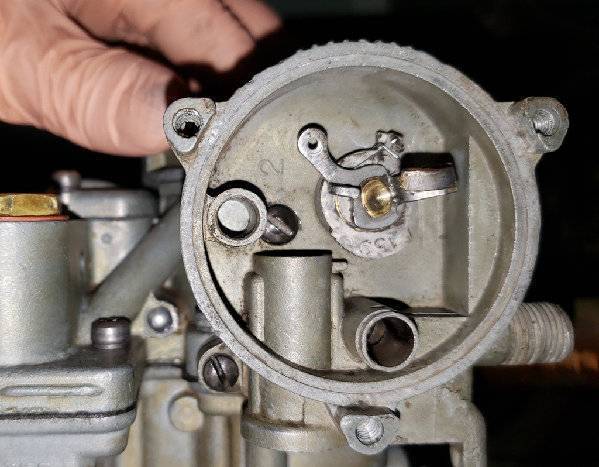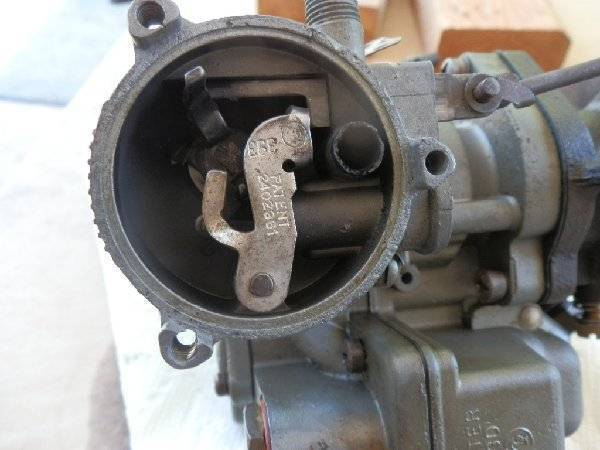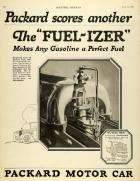|
Re: KPack's 1954 Panama
|
||||
|---|---|---|---|---|
|
Home away from home
|
I probably have it all too (except for the thermostatic cover) but won't know until I go to my shop in March, presuming I can travel then. In the meantime, can you pop off the cover and take a photo of what remains inside? Maybe you don't need anything,
Posted on: 2020/12/14 15:12
|
|||
|
All generalities are false.
Once I thought I was wrong but I was mistaken. Don Pierson Packard / IMPERIAL page CA DMV Licensed Vehicle VIN Verification 1951 Henney-Packard 3-Door Long Wheelbase Air Force Ambulance The 1951 Henney-Packard is For Sale! 1954 Packard Patrician 1954 Packard Patrician Parts Car 1956 Clipper Custom Sedan |
||||
|
||||
|
Re: KPack's 1954 Panama
|
||||
|---|---|---|---|---|
|
Home away from home

|
Thanks for the advice guys. Finally got a chance to work on the Panama today. Took a few pictures of the inside of the choke housing. I'm definitely missing a few things in there. The piston is present in the place it is supposed to be, but I'm missing all the linkage that connects to the choke lever.
Ross offered a complete carb at a good price that I will likely pick up. It would be handy to have a spare carb on hand to use for other parts as well. Started the car up a few times today and let it warm up to temp. I will need to redo timing and idle speed, but will need to borrow a friend's equipment for that. Throttle feels sticky....like it sometimes doesn't go back to normal idle. Kind of stays high sometimes. I think I need to go through and lube the throttle linkages. Probably will lube the throttle lever as well where it rotates in the throttle housing. Question, when I went to start the car after sitting for a week, it wouldn't start. No fuel getting to the carb. There was fuel in the glass bowl, but apparently the float bowl had dried out. Cranking for a few seconds didn't seem to move any fuel. Seemed odd to me. Putting some fuel into the float bowl allowed it to start right up. Would an air leak at a fuel line connection cause fuel to not pump? I did find a small leak at the connection shown on the picture....gas would dribble out every time more fuel would splash into the glass bowl (which seems to be empty most of the time). I've sent an email off to Dwight Heinmuller about it, since it seems like a defect in the connection on the flex line. -Kevin
Posted on: 2020/12/15 0:49
|
|||
|
||||
|
Re: KPack's 1954 Panama
|
||||
|---|---|---|---|---|
|
Forum Ambassador
|
Air leaks anywhere in the line could result in no fuel being pulled into the pump.
Pinholes in the steel fuel line particularly at some of the bends are well known and there are a couple of places in the tank where it can also happen. There may be just enough of a hole to allow air to enter but not be large enough to let fuel out so it is dripping and visible although usually you can see a dark or moist spot on the tube. If the car starts to seem like it is regularly running out of gas with the gauge still registering a little less than half or at approx 1/4 full suspect a pinhole in the pickup tube inside the tank. Unless there is a leak or a porous casting in the carb the float bowl drying out is more likely due to the much more volatile modern fuel evaporating or percolating due to the residual heat left over from the last time the engine ran. The dry bowl is one of the reasons many turn on and use an electric pump for several seconds to prime the system before starting the engine after a long sit. That bit of priming time can usually eliminate many seconds or several attempts of cranking time.
Posted on: 2020/12/15 10:13
|
|||
|
Howard
|
||||
|
||||
|
Re: KPack's 1954 Panama
|
||||
|---|---|---|---|---|
|
Home away from home

|
Thanks for the info Howard. I was hoping to not need an electric fuel pump, but I suppose it might be wise to install one.
For sure I have a leak at the spot shown on the picture. Dwight Heinmuller is kindly sending me a replacement hose, so we'll see if that makes the difference. I could possibly have a pinhole along the length of the original hard line from the tank, but I haven't noticed any wet spots on the ground or on the line. The tank is new so I would hope there is no leak in the pickup tube. -Kevin
Posted on: 2020/12/15 11:27
|
|||
|
||||
|
Re: KPack's 1954 Panama
|
||||
|---|---|---|---|---|
|
Home away from home
|
The seam where you pointed out the leak is where fuel might come out if the fitting isn't tight or if the flare is somehow not seating properly into the fitting. It could also indicate a crack at the tube's flare although that's not too likely.
On the choke, one arm inside appears to have been bent over and as that parts is swedged to the shaft, it cannot be replaced. You can try to carefully straighten it but it may break. The tab marked should point straight outward with the area below it being flat.
Posted on: 2020/12/15 12:10
|
|||
|
All generalities are false.
Once I thought I was wrong but I was mistaken. Don Pierson Packard / IMPERIAL page CA DMV Licensed Vehicle VIN Verification 1951 Henney-Packard 3-Door Long Wheelbase Air Force Ambulance The 1951 Henney-Packard is For Sale! 1954 Packard Patrician 1954 Packard Patrician Parts Car 1956 Clipper Custom Sedan |
||||
|
||||
|
Re: KPack's 1954 Panama
|
||||
|---|---|---|---|---|
|
Home away from home
|
Good Morning Kevin...Our 1949 288 Packard will start quickly if I drive her every day or every other day. If she sits for a week...like in the summer...it takes four (4) four second cranks, and she always catches on the fourth one...if your old girl will do the same, then I'd think that an electric fuel pump is not necessary...Miss Prudence gets along without one...enjoy your day...Ernie in Arizona
Posted on: 2020/12/15 13:46
|
|||
|
Caretaker of the 1949-288 Deluxe Touring Sedan
'Miss Prudence' and the 1931 Model A Ford Tudor 'Miss Princess' 
|
||||
|
||||
|
Re: KPack's 1954 Panama
|
||||
|---|---|---|---|---|
|
Home away from home

|
Does your choke have this part? It was missing in most of the Carter carbs I had. Finally found one in a scrap carb I bought. I think its purpose was to disengage the choke plate when the throttle was depressed. Might not have worked, seems like most were removed.
Posted on: 2020/12/16 11:52
|
|||
|
||||
|
Re: KPack's 1954 Panama
|
||||
|---|---|---|---|---|
|
Home away from home
|
Seems that Kevin's carburetor is also missing the fast idle link, the choke trip lever (that's the part in Tinman's photo), and the choke piston link. If the fast idle link is AWOL then the choke connector rod is also likely missing. The link and rod should have been visible in Kevin's 'Finished rebuild 2' photo in post 456, but they are missing.
It looks that what the carburetor was configured with a manual choke a lot of Carter's automatic choke hardware was removed. My immediate concern is the loss of the high idle feature. There may be climate conditions where the engine will start but either immediately stall, or run really rich because the throttle is not reset to high idle during warm-up. Kevin can ultimately determine when unloading is necessary, so in my mind that Carter hardware is optional. I've attached a file containing the US Patent 2,402,361 (see Tinman's photo). The operation of the automatic choke, fast idle, and vacuum/air flow/full throttle unloading are discussed in the disclosure. dp
Posted on: 2020/12/16 14:05
|
|||
|
||||
|
Re: KPack's 1954 Panama
|
||||
|---|---|---|---|---|
|
Home away from home

|
Don - that part was bent over to engage to arm inside the manual choke housing. I'm going to pick up the spare carb from Ross that hopefully has everything, and will just swap out everything inside the choke assembly. I'll keep the old manual choke parts in case I want or need to swap back for whatever reason.
Ernie - I don't think my battery is in great condition because after a few times cranking it gets noticeably weak. An electric fuel pump would be a nice backup to get fuel into the float bowl. Joe - definitely does not have that part, or most of the others that are shown in the picture. David - thanks for the link to the patent. Those pictures are definitely helpful. The conditions you describe regarding not having the high idle feature are familiar to me. Often when starting the car, it will start and immediately die before I can get the choke open. The next crank it will start right up and work. The car definitely runs rich. Maybe not as much as it did, but for sure not where it should be. Thanks everyone for the guidance. -Kevin
Posted on: 2020/12/16 17:42
|
|||
|
||||

 (108.94 KB)
(108.94 KB)


 (92.69 KB)
(92.69 KB)









